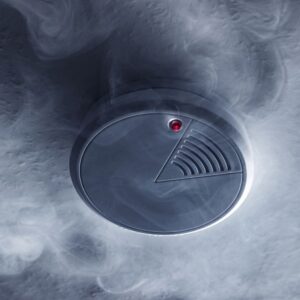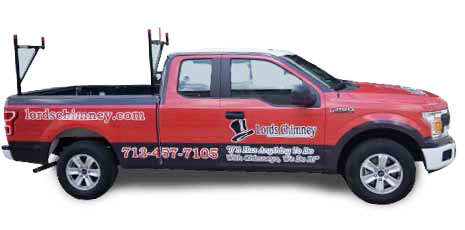Are you struggling with drafts and poor airflow when it comes to lighting fires in your fireplace? Finding the right solutions to these problems can be a frustrating and time-consuming process, especially if your system is prone to backdrafts due to its location, size, or style. Fortunately for homeowners in and around the Houston area, Lords Chimney has solutions.
Give us a call or book online with us today.
Fireplace Draft Problems?
You don’t wonder if you have a draft problem when you start your fireplace and smoke bellows into your home… you know you have one.
When you have a draft problem, the problems may not be just restricted to a problem with your fireplace, but may be a negative pressure problem in your home affecting your fireplace and other gas fired appliances. If combustion gases from these appliances cannot exit the building, they can accumulate in the building and result in serious health problems.
How Do I Know If I Have a Negative Pressure Problem?
Although poor draw at the fireplace may be the first symptom, there can be other less apparent indications, as well.
 In a warm humid climate such as ours, uncontrolled air drawn through the envelope of the building is unconditioned and carries moisture often resulting in mold in strange places, such as on the ceiling around air conditioning register grilles, at outlet and switch cover plates on outside walls, or around door and window casings.
In a warm humid climate such as ours, uncontrolled air drawn through the envelope of the building is unconditioned and carries moisture often resulting in mold in strange places, such as on the ceiling around air conditioning register grilles, at outlet and switch cover plates on outside walls, or around door and window casings.
You may also have a carbon monoxide detector that goes off frequently indicating flue gases accumulating in the building.
What causes negative pressure?
Negative relative pressure between the inside of your home and the outside can have many causes. Causes of negative pressures can be:
- related to poor design of the air conditioning system
- caused by damage to the air condition system
- due to poor design of ventilation systems
In addition, the problem can be local to a room or may be a building wide concern. Detecting the cause for a negative pressure conditions requires inspection, careful consideration, and, in some cases, special testing using gas detection equipment and low pressure manometers to evaluate.
Other Common Causes of Poor Chimney Draft
While draft problems are fairly common, there are a number of things that can cause them to occur. The following are a few of the many potential causes of a chimney draft problem.
- Air tight house: Keeping all the doors and windows shut keeps cold air out, but can also prevent your fireplace from drafting correctly. Often, cracking a window near the fireplace can allow fresh air in and help the fireplace vent properly.
- Keeping the damper closed: Partially or completely closing the damper while the fireplace is in use – even when a dying fire is smoldering – can cause smoke and gases to back up into your home.
- Improperly sized flue: If you’ve installed a new insert into an existing firebox, your flue may need to be resized. A flue that is too small can cause smoking issues as the byproducts of combustion have nowhere to go. Likewise, a flue that is too large can let too much cold air into the chimney and cause unwarranted creosote buildup.
- Chimney blockages: The presence of debris, animal nests, creosote buildup, and other blockages can prevent smoke and gas from properly venting. A dirty chimney is a major cause for bad ventilation.
- Damages/Poor Construction: In other cases, poor air flow is caused by some type of damage within the system. If you’re facing leaks or if there is cracking and crumbling throughout the structure, your chimney simply won’t be able to vent as efficiently.
All in all, there can be more than one cause for poor draft at a fireplace. Once a chimney sweep has performed an inspection and ruled out other probable causes you may find you have a negative pressure problem in your building.
What Are Common Solutions to Chimney Draft Problems?
If you suspect a problem with your fireplace draw, the first thing you should do is contact a chimney sweep. Eliminate other potential causes for poor draft at your fireplace first. If a negative pressure problem is suspected, hire an engineer or air conditioning contractor who can inspect the building and take interior pressure readings to provide guidance in developing a solution.
Corrections for negative pressure can include adjustments to air distribution in the building and improvements to ventilation air. However, design considerations should be discussed with an engineer to ensure the solution is proper and will positively affect the comfort of the building.
What Is a Ventilation Fan?
Ventilation fans draw the fumes, smoke, and gases that would typically enter your home up and out through the chimney. They are typically controlled by a device that is installed near the fireplace, allowing you full control when it comes to how fast the fan is operating.
Worried about extra noise? These devices are not loud or bothersome, and they are energy efficient, too. If you searching for something that is reliable and can handle your drafting issues, then look no further – our ventilation fans are the answer.
Do You Need A New Damper?
Sometimes drafting issues are due to something complicated like structural damage or an incorrect firebox size, but other times it’s as simple as replacing your damper! Having our team come in and inspect your entire system is always the best bet when dealing with draft and air flow issues, and it helps homeowners avoid jumping the gun and investing in big repair jobs when a simple replacement part was all that was needed.
Let us install a top-sealing damper for your system as soon as possible. These newer models work more efficiently than throat dampers, and they’ll provide you with the tight seal you’re looking for to keep out any cooler temps that may come our way.
How Chimney Drafting Issues Affect Indoor Air Quality
Many homeowners are surprised to learn that indoor air pollution is most often caused by interior sources of pollution – including drafty fireplaces. These drafting issues can affect air quality in two ways: first, by not bringing in enough fresh outdoor air to dilute pollutants, and second, by not venting and carrying air pollutants out of the home.
These conditions are often made worse by high temperatures and humid weather, weather conditions which the Houston area is used to experiencing.
What Can I Expect From Lords Chimney?
What can you expect when you depend on the Lords Chimney crew? When you hire our CSIA certified technicians, you can put your mind at ease because we always put your needs first. We are honest, experienced, and thorough. When it comes to the latest techniques and technological advances, we are on it.
If you are ready to get the care you deserve, call us now at 832-280-9964 to set up an appointment!

